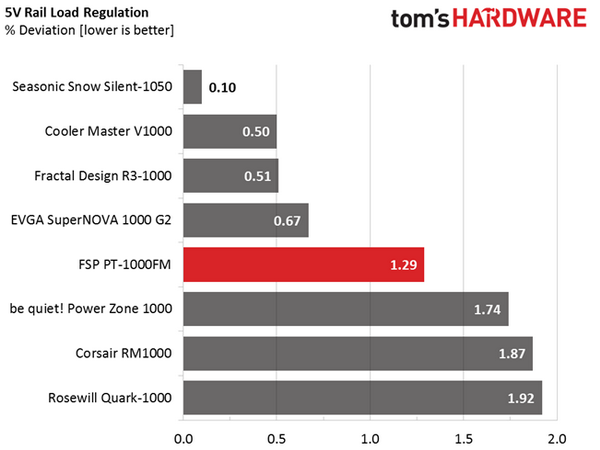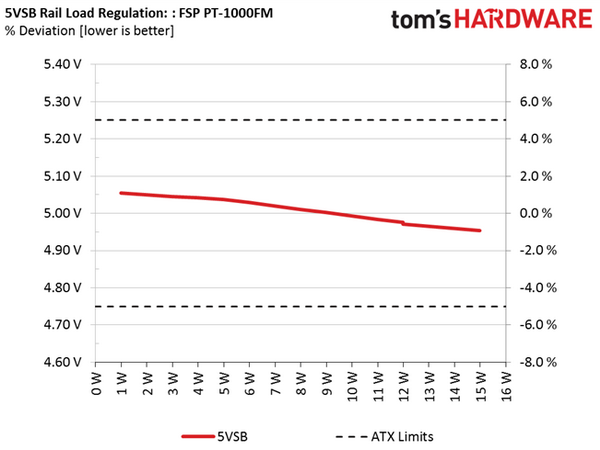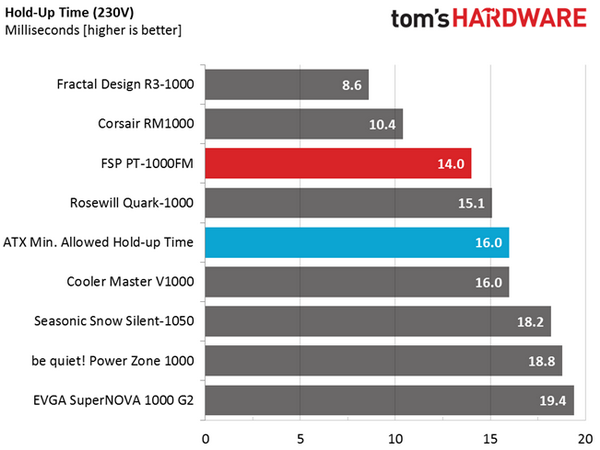FSP Aurum PT 1000W Power Supply Review
FSP's Aurum PT series PSUs are 80 PLUS Platinum-certified and fully modular. Today we will take a look at the series' 1000W mid-level unit.
Why you can trust Tom's Hardware
Load Regulation, Hold-Up Time And Inrush Current
To learn more about our PSU tests and methodology, please check out How We Test Power Supply Units.
Primary Rails And 5VSB Load Regulation
Load Regulation testing is detailed here.
The following charts show the voltage values of the main rails, recorded over a range from 40W to the maximum specified load, and the deviation (in percent) for the same load range. You will also find a chart showing how the 5VSB rail deals with the load we throw at it.








Hold-Up Time
Our hold-up time tests are described in detail here.


The hold-up time (AC loss to PWR_OK) doesn't meet the ATX spec's minimum requirement, which is 16ms, so the PSU failed this test.
Inrush Current
For details on our inrush current testing, please click here.


The registered inrush current was high with both 115V and 230V inputs. Obviously, FSP should have used a larger NTC thermistor to restrict it.
Get Tom's Hardware's best news and in-depth reviews, straight to your inbox.
Load Regulation And Efficiency Measurements
The first set of tests reveals the stability of the voltage rails and the PSU's efficiency. The applied load equals to (approximately) 10 to 110 percent of the maximum load the supply can handle, in increments of 10 percentage points.
We conducted two additional tests. During the first, we stressed the two minor rails (5V and 3.3V) with a high load while the load at +12V was only 0.10A. This test reveals whether the PSU is Haswell-ready or not. In the second test, we determined the maximum load the +12V rail could handle while the load on the minor rails was minimal.
| Test | 12V (A/V) | 5V (A/V) | 3.3V (A/V) | 5VSB (A/V) | Power DC/AC (W) | Efficiency (%) | Fan Speed (RPM) | Fan Noise dB(A) | Temp In/Out (°C) | PF/AC (V) |
|---|---|---|---|---|---|---|---|---|---|---|
| 1 | 6.499A | 1.927A | 1.960A | 0.990A | 99.75 | 87.63 | 900 | 33.6 | 38.86 | 0.979 |
| 12.030V | 5.182V | 3.365V | 5.037V | 113.83 | 41.7 | 115.0V | ||||
| 2 | 14.042A | 2.897A | 2.945A | 1.191A | 199.64 | 90.89 | 900 | 33.6 | 39.28 | 0.994 |
| 12.019V | 5.173V | 3.359V | 5.029V | 219.66 | 42.29 | 115.0V | ||||
| 3 | 21.961A | 3.382A | 3.459A | 1.390A | 299.8 | 92.06 | 900 | 33.6 | 41.93 | 0.996 |
| 12.010V | 5.168V | 3.352V | 5.020V | 325.66 | 45.21 | 115.0V | ||||
| 4 | 29.875A | 3.868A | 3.944A | 1.595A | 399.59 | 92.38 | 900 | 33.6 | 42.5 | 0.997 |
| 11.998V | 5.161V | 3.345V | 5.011V | 432.55 | 46.12 | 115.0V | ||||
| 5 | 37.465A | 4.848A | 4.941A | 1.795A | 499.55 | 92.30 | 900 | 33.6 | 42.87 | 0.998 |
| 11.987V | 5.154V | 3.338V | 5.002V | 541.23 | 46.91 | 114.9V | ||||
| 6 | 45.070A | 5.828A | 5.942A | 2.002A | 599.5 | 91.97 | 900 | 33.6 | 43.16 | 0.998 |
| 11.975V | 5.146V | 3.332V | 4.993V | 651.88 | 47.57 | 114.9V | ||||
| 7 | 52.694A | 6.807A | 6.949A | 2.205A | 699.49 | 91.30 | 900 | 33.6 | 44.41 | 0.999 |
| 11.964V | 5.138V | 3.323V | 4.984V | 766.15 | 49.08 | 114.9V | ||||
| 8 | 60.321A | 7.795A | 7.961A | 2.411A | 799.39 | 90.68 | 1250 | 42.5 | 44.97 | 0.999 |
| 11.953V | 5.130V | 3.315V | 4.975V | 881.6 | 50 | 114.9V | ||||
| 9 | 68.403A | 8.293A | 8.493A | 2.411A | 899.38 | 89.97 | 1640 | 46.1 | 46.97 | 0.999 |
| 11.941V | 5.124V | 3.309V | 4.971V | 999.65 | 52.48 | 114.9V | ||||
| 10 | 76.244A | 8.789A | 8.997A | 3.025A | 999.18 | 89.12 | 2060 | 51.5 | 47.46 | 0.999 |
| 11.929V | 5.118V | 3.301V | 4.954V | 1121.2 | 53.36 | 114.9V | ||||
| 11 | 84.707A | 8.800A | 9.013A | 3.030A | 1099.12 | 88.46 | 2120 | 51.8 | 47.85 | 0.999 |
| 11.917V | 5.110V | 3.295V | 4.949V | 1242.55 | 54.4 | 114.9V | ||||
| CL1 | 0.100A | 19.016A | 19.001A | 0.004A | 162.6 | 85.94 | 900 | 33.6 | 43.7 | 0.994 |
| 12.022V | 5.153V | 3.336V | 5.040V | 189.2 | 47.61 | 115.0V | ||||
| CL2 | 82.940A | 1.002A | 1.004A | 1.002A | 1002.96 | 89.73 | 1830 | 49.2 | 46.25 | 0.999 |
| 11.930V | 5.129V | 3.317V | 5.001V | 1117.8 | 51.85 | 114.9V |
At one point we were worried that the fan-control circuit was defective, since the fan refused to increase speed even under very stressful conditions at well over 40 °C ambient temperatures and high loads. FSP engineers decided to offer a relaxed fan profile on this PSU, and although that's great news to users looking for a quiet 1kW supply, we would prefer a different approach offering more variation of the fan's speed. With the current profile, the fan increases its speed at around 400 RPM almost instantly.
The PSU managed to deliver its full power flawlessly under high operating temperatures; this time we pushed it well above 45 °C to check the fan speed under very tough conditions. The only problem we observed was the HDB fan's loud noise as it worked to push hot air out of the PSU's internals.
In the performance section, load regulation was very good. On top of that, the PSU managed to clear all 80 PLUS Platinum requirements, even at the high temperatures we applied during the above test sessions. This is something that shouldn't be taken lightly. As the operating temperature increases, efficiency takes a significant hit. The 80 PLUS organization tests at 23 °C, a highly unrealistic ambient temperature for PSU testing in our opinion. Inside of a chassis, you'll never find 23-degree temps.
Current page: Load Regulation, Hold-Up Time And Inrush Current
Prev Page A Look Inside And Component Analysis Next Page Efficiency, Temperatures And Noise
Aris Mpitziopoulos is a contributing editor at Tom's Hardware, covering PSUs.
-
Giannis Karagiannis Just ordered one! Very comprehensive review! It is a bit strange that thanks to your recent articles I can choose a power supply with much greater confidence than a CPU or VGA. Keep up the good work!Reply -
Vosgy ReplyJust ordered one! Very comprehensive review! It is a bit strange that thanks to your recent articles I can choose a power supply with much greater confidence than a CPU or VGA. Keep up the good work!
Man haven't seen anyone call them Video Graphics Accelerators in years, kudos to you good sir. -
Covaylent Nice work, Aris, as usual.Reply
Would you mind commenting on the infrared images? Some of those hotspots seem quite hot - am I just reading the images incorrectly? -
Aris_Mp Indeed some hotspots are very hot since I usually take this shots with the PSU operating at very high ambient temperatures. Some parts inside the PSU may operate at up to 100C under such conditions.Reply